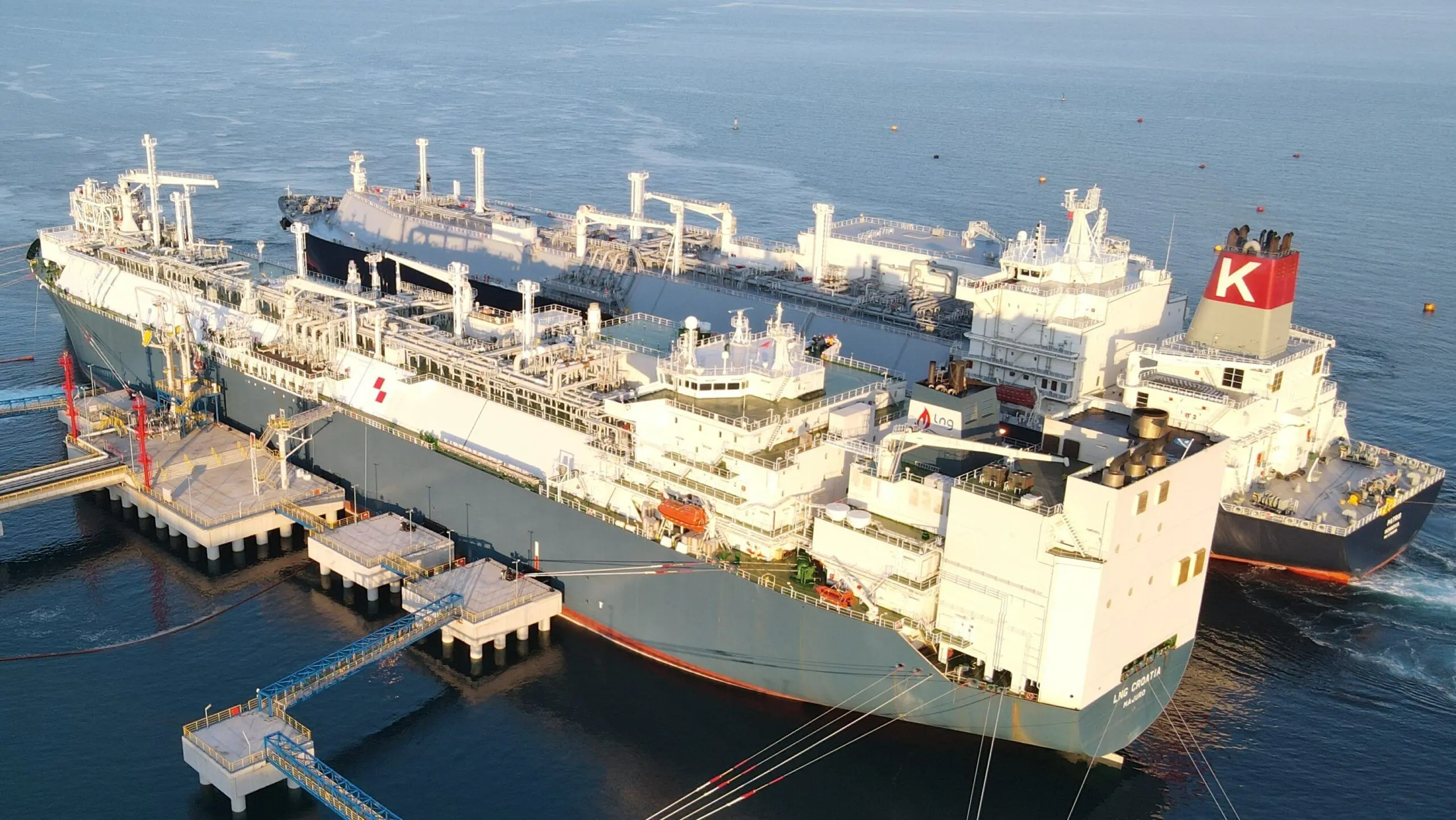The LNG terminal (hereinafter, the terminal) is in the municipality of Omišalj on the island of Krk, in the Republic of Croatia.
The terminal has a geopolitical and strategic dimension within the framework of strengthening the European energy market and increasing the security of gas supply to Croatia and the neighbouring countries of Southeast Europe that want to secure a new reliable gas supply route for themselves.
This project is strategically important for the European Union and the Republic of Croatia. The terminal is included in the EU Projects of Common Interest (PCI) list and has been awarded grants of 101.4 million euros.
The terminal consists of several key parts:
- FSRU (floating storage and regasification unit) vessel “LNG Croatia”
- Shore part of the terminal

JETTY
A reinforced concrete element built on columns on which high-pressure marine loading arms, gangway, fire extinguishing monitors, and other auxiliary equipment are located. On the head of the jetty, fenders were installed to support the FSRU vessel
MOORING DOLPHINS
Reinforced concrete elements are built on pillars with quick-release hooks, with which the FSRU vessel and the LNG carrier are moored to the Terminal.
BREASTING DOLPHINS
Reinforced concrete elements are made on pillars with quick-release hooks with which the FSRU vessel is moored to the Terminal. Fenders for FSRU support are installed on each breasting dolphin.
QUICK RELEASE HOOKS
The mooring system elements are located on the jetty. The FSRU vessel and the LNG carrier are moored at the Terminal with them.
HIGH PRESSURE OFFLOADING ARMS
They are located at the head of the jetty and represent the connection between the FSRU vessel and the shore part of the Terminal. With them, natural gas from the FSRU vessel is sent to the shore part of the Terminal and further to the gas transport system.
FIRE MONITORS
Elements of the Terminal's fire protection system are located on the jetty. In the event of a fire, they protect the jetty and support the FSRU vessel.
GANGWAY
A collapsible structure connecting the shore part of the Terminal and the deck of the FSRU vessel.
CONTROL BUILDING
Central facility on the shore part of the Terminal, where continuous operational supervision and control of the terminal is ensured 24/7/365
PIG LAUNCHING STATION
A technological facility in the service of maintenance and inspection of the high-pressure connecting gas pipeline through which the Terminal is connected to the Omišalj gas hub, i.e. to the gas transmission system of the Republic of Croatia.
The connecting gas pipeline has a nominal diameter of 1000 mm, a maximum working pressure of 100 bar, and a total length of 4.2 km. Its starting point is the jetty, and its endpoint is the Omišalj gas hub. The primary function of the connecting gas pipeline is the send out of natural gas from the terminal and its delivery to the gas transmission system of the Republic of Croatia.
FIRE WATER TANK
A facility on the shore part of the terminal that provides water for fire protection of the terminal.

FSRU (Floating Storage Regasification Unit) „LNG CROATIA“
A floating unit used for the storage, regasification, and send out of natural gas to the gas transmission system.
LNG CARRIER
It is used to deliver LNG. After docking and mooring with the FSRU vessel and connecting the cryogenic hoses, the previously agreed amount of LNG is discharged from the LNG carrier to the FSRU.
REGASIFICATION MODULE
A technological element is installed on the bow of an FSRU vessel, where natural gas transitions from a liquid state (-162°C) to a gaseous state occurs.
POWER MODULE
A technological element installed on the stern of the FSRU vessel generates electricity for the FSRU vessel and the shore part of the terminal.
LNG STORAGE TANKS
Part of the FSRU vessel in which the transferred LNG is stored. FSRU vessel „LNG CROATIA“ is equipped with four LNG storage tanks with a total capacity of 140,206 m³.
JETTY
Reinforced concrete element made on colums on which high pressure offloading arms, gangway, fire monitors and other auxiliary equipment are located. Fenders for FSRU support are installed on jetty head as well.
MOORING DOLPHINS
Reinforced concrete elements made on colums on which quick release hooks are installed. FSRU and LNG carrier are moored at the Terminal by mooring ropes connected to quick release hooks
BREASTING DOLPHINS
Reinforced concrete elements made on colums on which quick release hooks are installed. FSRU and LNG carrier are moored at the Terminal by mooring ropes connected to quick release hooks. Fender for FSRU support are installed on each breasting dolphin.
QUICK RELEASE HOOKS
Elements of mooring system located on the mooring and breasting dolphins. FSRU vessel and LNG carrier are moored to the Terminal by mooring ropes.
FENDERS
Elements of Terminal's mooring system installed along the breasting dolphins and jetty head which serve to support the FSRU vessel.
HIGH PRESSURE OFFLOADING ARMS
Located on the jetty head and represent gas line between FSRU vessel and onshore part of the Terminal. Natural gas is being sent from FSRU through high pressure offloading arms to the onshore part of the Terminal.
FIRE MONITORS
Elements of Terminal's firefighting system located on the jetty head. In case of danger, they are providing fire protection for the jetty and also providing firefighting support to the FSRU vessel.
GANGWAY
Folding structure connecting Terminal and the deck of the FSRU vessel thus allowing access to personnel from the onshore part of the Terminal to the FSRU vessel and vice versa.
FSRU VESSEL
FSRU (Floating Storage & Regasification Unit) vessel consists of LNG storage tanks, equipment for LNG loading and unloading and LNG regasification equipment. All processes on board are monitored by the operator from the central control room while autonomous safety systems are in operation in case of fire and gas occurrence.
The FSRU vessel is equipped with four LNG storage tanks with a total capacity of 140,206 m3, three LNG regasification units with a maximum regasification rate of 451,840 m3/h and with power plant which generates electricity for the purpose of operating the terminal.
Regasification of LNG is performed by exchanging the heat of seawater and LNG over glycol as an intermediate fluid. Seawater transfers its heat to glycol and is afterwards discharged back to the sea without any treatment. The glycol afterwards transfers heat to the LNG which is regasified during this process. Natural gas is then through high-pressure offloading arms delivered to gas transmission system of the Republic of Croatia.
ONSHORE PART OF THE TERMINAL
The onshore part of the LNG terminal consists of the jetty head, breasting dolphins for FSRU berthing, mooring dolphins for FSRU and LNG carrier berthing, quick release hooks, the access bridge, the high-pressure offloading arms with connecting pipeline, pig launching station, firefighting system, terminal control building, and associated facilities.
The FSRU vessel is moored to the jetty and connected to the high-pressure offloading arms through which natural gas enters the connecting pipeline. In addition to the mooring of the FSRU, the jetty is also designed for the indirect acceptance of the LNG carrier, which is moored side by side to the FSRU vessel during transfer of the LNG.
Jetty head is the main part of the jetty, constructed as a platform on concrete piles. High pressure offloading arms with a connection to the connecting pipeline are located on the top part of the jetty head. The natural gas is transported through the connecting pipeline to the Omišalj gas node where the connecting pipeline is connected to transmission system of the Republic of Croatia.
Breasting dolphins for FSRU vessel berthing are constructed on concrete piles, equipped with fenders for safe berthing of the FSRU vessel.
The mooring dolphins for FSRU vessel and LNG carrier mooring are constructed on concrete piles, equipped with quick release hook mooring system to carry out unmooring of FSRU vessel in a safe and fast way in case of emergency.
The jetty head, breasting dolphins and mooring dolphins for FSRU and LNG carrier berthing are connected by catwalks. A 90 m long access bridge, with access pavement and sidewalk, connects the jetty head with onshore part of the jetty.
The connecting gas pipeline, with nominal diameter 1000 mm and operating pressure of 100 bar is 4.2 km long. Starting point of the connecting pipeline is located at the jetty head and the end point is located on the Omišalj gas node. Main function of the connecting pipeline is send-out of the natural gas from terminal and its delivery to transmission system of the Republic of Croatia.
The connecting water supply line, with nominal diameter 90 mm and with a total length of 2,5 km is connected to the public water supply system at manhole near the state road D102. Main function of the water supply system is to provide water on the LNG facility for sanitary purposes, as well as for the filling of terminal firefighting water tank.
MAIN TECHNICAL CHARACTERISTICS
LNG carriers with a capacity of 3,500 mᵌ to 265,000 mᵌ can moor at the terminal next to the FSRU vessel.
The allowed lay time for a standard cargo quantity (up to 140,000 mᵌ) is 40 consecutive hours. If the LNG quantity to be discharged is not a standard cargo quantity, the LNG terminal operator and the LNG terminal User agree on a longer or shorter allowed lay time, depending on the cargo quantity.
The discharge rate from the LNG carrier to the FSRU is a maximum of 8,000 mᵌ /h.
During LNG discharge, the FSRU vessel may regasify at a technical LNG regasification capacity equal to 338,000 mᵌ /h.





